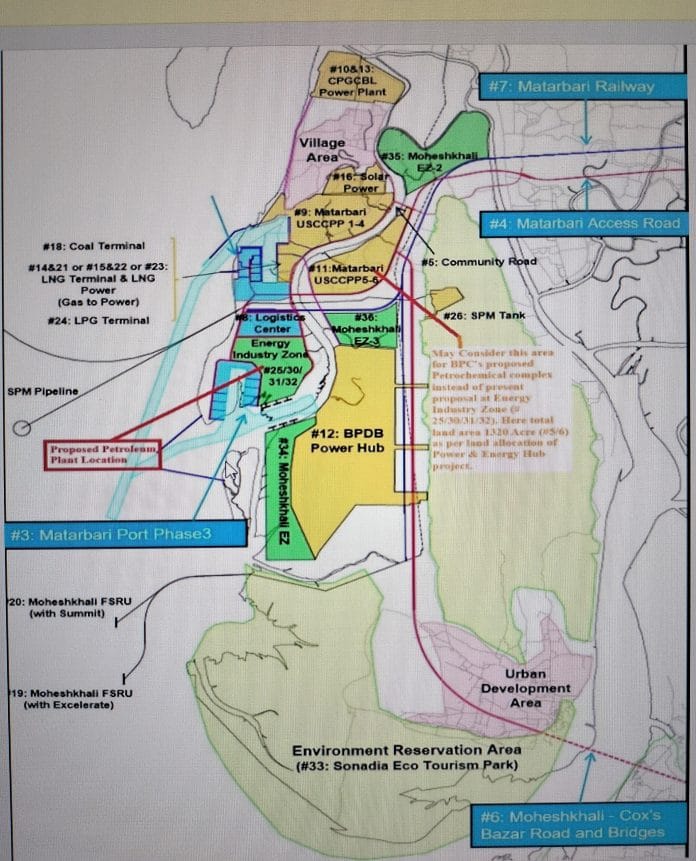Bangladesh is eyeing a massive transformation of its economic landscape through the Maheshkhali-Matarbari Integrated Development Initiative (MIDI), a long-term project aimed at turning the coastal region into one of South Asia’s largest industrial and maritime hubs.
A recent study conducted by the Japan International Cooperation Agency (JICA) projects that the Maheshkhali-Matarbari region could attract between $60 to $65 billion in investment over the next two to three decades.
This level of development is expected to generate employment for approximately 2.5 million people, both directly and indirectly, and contribute up to $150 billion to the national GDP.
“This is not just another development plan—this is a game-changer for Bangladesh,” said Ashiq Chowdhury, executive chairman of the Bangladesh Investment Development Authority (BIDA) at a press conference on Wednesday.
“Maheshkhali and Matarbari will become engines of sustainable growth, attracting global investment and reshaping our role in regional and international trade,” he added.
The government’s ambitious plan envisions transforming Maheshkhali into a modern port city akin to Shanghai or Singapore, leveraging its strategic location and integrating deep-sea ports, energy terminals, power plants, and special economic zones, added Prashanta Kumar Mondal, Bida’s spokesperson.
“This will be one of the country’s largest commercial hubs,” he said.
The project aims to integrate infrastructure development across four major sectors—ports and logistics, manufacturing, energy and power, and fisheries—under a unified master plan that is expected to be finalized by the fourth quarter of 2025.
Port and Logistics Infrastructure
One of the most strategic components of the project is the development of the Matarbari Deep Sea Port. With a natural depth of 18.5 meters, it will be capable of accommodating large vessels that currently cannot dock at Bangladesh’s existing ports. Once fully operational, the port is expected to increase the country’s overall port capacity by nearly 50 percent over the next 30 years.
It is also projected to handle a significant share of the nation’s cargo traffic—25 percent of bulk cargo and 45 percent of container cargo—substantially reducing import costs. For example, the cost of a standard LPG cylinder could drop by up to 50 taka due to reduced logistical expenses.
Manufacturing Sector
The hub will support the growth of nine key manufacturing sectors, including steel, agriculture and food processing, automotive, and electronics.
Long-term projections suggest that the scheme will help save the country $6 billion in foreign exchange through local production with nearly 10 percent contribution to the national manufacturing sector.
Energy and Power
In the energy and power sector, Maheshkhali-Matarbari is being positioned as the country’s primary energy import and processing zone. With national electricity demand rising at an average rate of 6.7 percent annually, the region will play a crucial role in meeting future energy needs.
A proposed refinery with a capacity of 8 to 10 million tonnes per annum could fulfill 35 percent of Bangladesh’s fuel demand over the next 30 years and save about $3.4 billion in foreign currency each year.
Fisheries Sector
The fisheries sector, too, stands to benefit significantly. Although the Bay of Bengal holds vast untapped marine resources, they remain largely underutilized. Bangladesh’s membership in the Indian Ocean Tuna Commission opens up new opportunities in deep-sea fishing, particularly for tuna.
As part of this initiative, 28 longliner fishing vessels have already been approved, and the new infrastructure will make it easier to export seafood—such as shrimp from the Chakaria region—to markets in Europe, the U.S., and Japan. Processed scallop exports alone could generate a $500 million market.
Economic Impact
The JICA study estimates that nearly $47–48 billion of the total investment will come from the private sector, including 10% from foreign direct investment (FDI). The project is expected to contribute $150 billion to the national GDP over time.
According to BIDA, the Maheshkhali-Matarbari initiative will be rolled out in three phases: Incubation, Expansion, and Diversification. The planning and implementation roadmap is already underway, with a 120-day work plan currently guiding the completion of the project’s masterplan.
Experts believe that if executed successfully, the MIDI project will not only secure long-term economic resilience for the Cox’s Bazar region but also serve as a powerful engine for national growth. With its integrated approach and massive scale, the project has the potential to reshape Bangladesh’s economic destiny—placing it firmly on the map as a global trade and investment destination.

